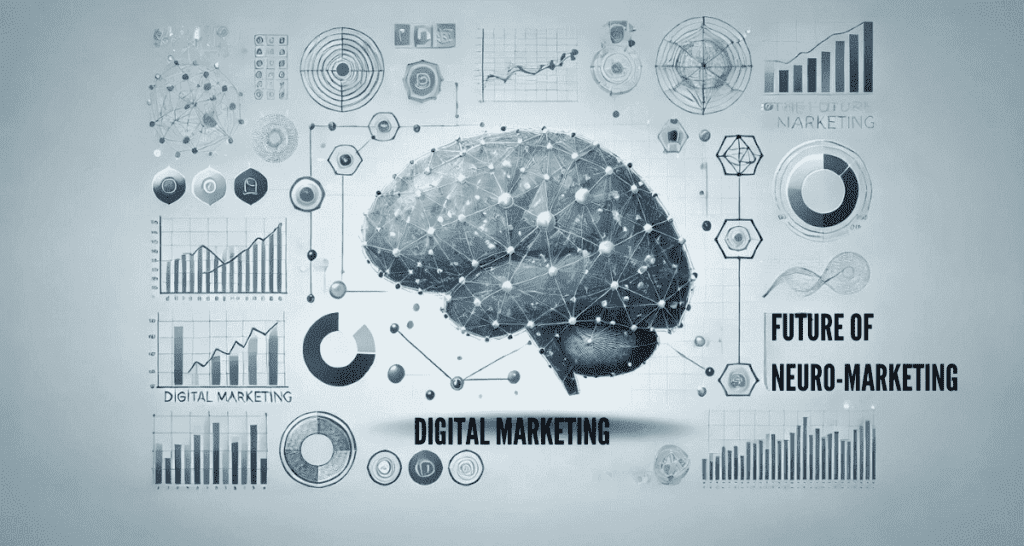Introduction
Definition of Neuro-Marketing
Neuro-marketing is an intriguing field that merges neuroscience with marketing. It focuses on understanding how people’s brains respond to marketing stimuli. By using techniques like EEG and fMRI, neuro-marketing helps marketers understand the emotional and cognitive reactions of consumers. This knowledge is incredibly valuable for creating more effective marketing campaigns.
Evolution of Neuro-Marketing
Neuro-marketing has come a long way since its inception. Initially, it was primarily used in academic research. However, over time, businesses have started to recognize its potential. Today, it’s integrated into various digital marketing strategies, helping companies to fine-tune their marketing efforts and achieve better results.
Purpose of the Article
In this article, we’ll explore the future of neuro-marketing in digital marketing. We’ll discuss emerging trends, technologies, and the benefits of using neuro-marketing. This article aims to provide valuable insights for both beginners and professionals, helping you stay ahead in the ever-evolving world of digital marketing.
Understanding Neuro-Marketing
The Science Behind Neuro-Marketing
Neuro-marketing is grounded in the principles of neuroscience and psychology. It involves studying the brain’s responses to various marketing stimuli using advanced techniques like electroencephalography (EEG) and functional magnetic resonance imaging (fMRI). These tools help marketers see which parts of the brain are activated by specific advertisements or branding efforts. By understanding these responses, companies can create more compelling and effective marketing campaigns.
Current Applications in Digital Marketing
Today, many companies are leveraging neuro-marketing to enhance their digital marketing strategies. For instance, businesses use eye-tracking technology to see where consumers focus their attention on a webpage. This data helps in optimizing website design and improving user experience. Additionally, neuro-marketing techniques are used to test the effectiveness of advertisements and refine brand messaging. These applications not only improve marketing performance but also help in building stronger connections with the target audience.
Successful Examples of Neuro-Marketing Strategies
The Future of Neuro-Marketing
Emerging Trends and Technologies
The future of neuro-marketing is incredibly promising, with several emerging trends and technologies set to revolutionize the field. Artificial intelligence (AI) and machine learning are becoming integral to neuro-marketing strategies. These technologies enable real-time data analysis, providing deeper insights into consumer behavior. Additionally, the integration of advanced data analytics allows for more personalized and targeted marketing efforts.
Real-Time Emotion Detection
One of the most exciting developments is the use of real-time emotion detection. This technology can analyze facial expressions, voice tones, and other physiological signals to determine a consumer’s emotional state. Marketers can use this data to tailor their messages and create more impactful advertising campaigns.
Predictive Analytics and Consumer Behavior
Predictive analytics is another area where neuro-marketing is making significant strides. By analyzing past behaviors and preferences, predictive analytics can anticipate future consumer needs and desires. This capability allows marketers to create highly personalized experiences that resonate with individuals on a deeper level. As a result, customer engagement and satisfaction are likely to improve, leading to higher conversion rates and increased loyalty.
Ethical Considerations
As neuro-marketing continues to evolve, ethical considerations become increasingly important. Privacy concerns are at the forefront, as the collection and use of neurological data must be handled with care. Marketers need to ensure that they are transparent about their data practices and respect consumer privacy. Additionally, it is crucial to use neuro-marketing data ethically, avoiding manipulative practices that could harm consumers or erode trust.
Real and Legit Examples
Brands Leveraging Neuro-Marketing
Several prominent brands have successfully leveraged neuro-marketing to enhance their marketing strategies. For instance, Coca-Cola has used neuro-marketing to understand the emotional impact of its advertisements. By analyzing brain activity, the company has been able to create more engaging and memorable ads that resonate with consumers on an emotional level.
Another example is Nike, which uses neuro-marketing to boost consumer engagement. By studying how consumers react to different aspects of their marketing campaigns, Nike can refine its messaging and visuals to create a more compelling brand experience.
Strategies and Analytics
Successful neuro-marketing strategies are grounded in thorough data analysis and real-time feedback. Companies like Procter & Gamble have used neuro-marketing to test product packaging and advertisement effectiveness. By leveraging EEG and eye-tracking data, they can optimize their designs to attract more consumer attention and drive sales.
Real Analytics and Performance Metrics
Analyzing the performance metrics of these campaigns is crucial. Real analytics, such as engagement rates, conversion rates, and return on investment (ROI), provide valuable insights into the effectiveness of neuro-marketing strategies. Infographics and visual data representations can help in understanding the impact and ROI of these campaigns.
Benefits of Neuro-Marketing in Digital Marketing
Enhanced Consumer Insights
One of the primary benefits of neuro-marketing is the enhanced understanding of consumer motivations. By delving into the subconscious mind, marketers can uncover deeper insights into what drives consumer behavior. This knowledge allows for the creation of more personalized marketing messages and content that truly resonate with the audience.
Improved Ad Campaign Performance
Neuro-marketing techniques lead to improved ad campaign performance. By understanding how consumers react to different stimuli, marketers can craft more effective advertisements that capture attention and drive action. This results in higher conversion rates and a better return on investment (ROI) for marketing efforts.
Building Stronger Brand Loyalty
By creating emotional connections with consumers, neuro-marketing helps in building stronger brand loyalty. When consumers feel a deep emotional connection with a brand, they are more likely to remain loyal and become repeat customers. This long-term relationship is beneficial for both the brand and the consumer, leading to sustained business growth.
Challenges and Solutions
Technological Barriers
Despite its potential, neuro-marketing faces several challenges. One of the main barriers is the high cost of neuro-marketing tools. Advanced technologies like EEG and fMRI are expensive and require specialized expertise to operate and interpret. Additionally, the complexity of data analysis can be daunting for many businesses.
Ethical and Privacy Issues
Ethical and privacy issues are significant concerns in neuro-marketing. Collecting and using neurological data must be done with utmost care to ensure consumer privacy and trust. Marketers must be transparent about their data collection practices and obtain proper consent from consumers.
Strategies to Overcome Challenges
To overcome these challenges, companies can explore cost-effective neuro-marketing solutions. Partnering with specialized firms or investing in scalable tools can help mitigate costs. Ensuring transparency and adhering to ethical guidelines are crucial for maintaining consumer trust and fostering positive relationships.
Step-by-Step Guide for Beginners and Professionals
Getting Started with Neuro-Marketing
For those new to neuro-marketing, it’s essential to start with the basics. Begin by familiarizing yourself with fundamental concepts and techniques. Invest in essential tools like eye-tracking software and consumer behavior analysis platforms. Understand how to interpret data and apply insights to your marketing strategies.
Advanced Techniques for Professionals
For experienced marketers, diving into advanced neuro-marketing techniques can yield significant benefits. Explore the integration of AI and machine learning to enhance data analysis. Use real-time emotion detection tools to refine your marketing messages. Continuously test and optimize your campaigns based on the insights gained from neuro-marketing data.
Measuring Success and ROI
Measuring the success of neuro-marketing campaigns is crucial. Identify key performance indicators (KPIs) that align with your marketing objectives. Regularly analyze data to monitor progress and make necessary adjustments. Use tools like Google Analytics and other analytics platforms to monitor engagement rates, conversion rates, and overall ROI.
Conclusion
Recap of Key Points
In this article, we’ve explored the future of neuro-marketing in digital marketing. We’ve discussed emerging trends, technologies, and the benefits of using neuro-marketing. From enhanced consumer insights to improved ad campaign performance, neuro-marketing offers numerous advantages for businesses.
Final Thoughts
As the field of neuro-marketing continues to evolve, it’s essential for marketers to stay informed and adapt to new trends. By embracing neuro-marketing, businesses can create more effective and impactful marketing campaigns, ultimately driving growth and success.
Author
-

John, our Website Manager, is the architect behind seamless online experiences. With a keen eye for detail, he ensures your digital space is not only visually stunning but also intuitively functional. From design optimization to user-centric features, John's expertise lies in crafting websites that captivate and convert. Trust him to elevate your online presence to new heights.
View all posts




